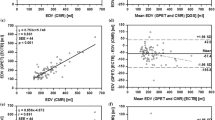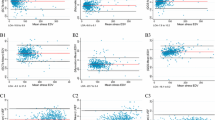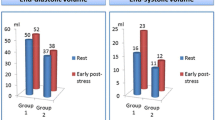Abstract
Objectives
This study sought to evaluate an imaging approach using gated99mTc-MIBI (MIBI) SPECT and gated18F-FDG (FDG) PET for assessment of myocardial viability and cardiac function.
Methods
Forty-eight patients (38 men, mean age 68.1 ± 9.6 years) underwent ECG-gated FDG PET and MIBI SPECT within a week. The baseline diagnoses were coronary artery disease (31), mitral regurgitation (1), paroxysmal arrhythmia (10), and dilated cardiomyopathy (6). The gated FDG PET data were analyzed using pFAST software, and the gated MIBI SPECT data were analyzed using QGS software. Fifteen patients were diagnosed with myocardial infarction, and follow-up study was performed to assess the functional outcome four months later. An improvement in LVEF of >5% was defined as significant. The LV myocardium was divided into 17 segments, and regional defect scores were visually assessed using a 4-point scale for each segment (0 = normal, 1 = mildly reduced, 2 = moderately reduced, 3 = absent). A segment with a greater defect score on MIBI SPECT than on FDG PET was defined as a mismatch. The patients were divided into two groups: those with at least two mismatched segments (MM-group), and those with none or one (M-group).
Results
LVEF, EDV and ESV measured by gated FDG PET were highly correlated with those obtained by gated MIBI SPECT (r = 0.848, 0.855 and 0.911, p < 0.0001, respectively). The mean values of LVEF did not differ significantly, but EDV and ESV obtained by gated FDG PET were significantly grater than those obtained by gated MIBI SPECT (p < 0.0001). In 15 patients diagnosed with myocardial infarction, a significant association (p < 0.05) was found between the relative uptake of FDG PET and MIBI SPECT and the functional outcome 4 months later. Global LV function improved in 6 of the 8 patients showing mismatch but in only 1 of the 7 patients with matched defects, resulting in a sensitivity of 86% and specificity of 75%. The overall accuracy to predict global functional outcome was high (80%).
Conclusion
This imaging approach allows accurate evaluation of myocardial viability. Furthermore, the high correlations of gated FDG PET and gated MIBI SPECT measurements hold promise for the assessment of left ventricular function using gated FDG PET.
Similar content being viewed by others
References
Rahimtoola SH. The hibernating myocardium.Am Heart J 1989; 117:211–221.
Bolli R. Myocardial “stunning” in man.Circulation 1992; 86:1671–16911.
Bodenheimer MM, Banka VS, Hermann GA, Trout RG, Pasdar H, Helfant RH. Reversible asynergy. Histopathological and electrographic correlations in patients with coronary artery disease.Circulation 1976; 53:792–7966.
Brundage BH, Massie BM, Botvinick EH. Improved regional ventricular function after successful surgical revascularization.J Am Coll Cardiol 1984; 3:902–9088.
Altehoefer C, Kaiser HJ, Dorr R, et al. Fluorine-18 deoxyglucose PET for assessment of viable myocardium in perfusion defects in99mTc-MIBI SPECT: a comparative study in patients with coronary artery disease.Eur J Nucl Med 1992; 19:334–3442
Lucignani G, Paolini G, Landoni C, et al. Presurgical identification of hibernating myocardium by combined use of technetium-99m hexakis 2-methoxy-isobutyI-isonitrile single photon emission tomography and fluorine-18 fluoro-2-deoxy-D-glucose positron emission tomography in patients with coronary artery disease.Eur J Nucl Med 1992; 19:874–8811.
Zhang X, Liu X, Shi R, et al. Evaluation of the clinical value of combination of99mTc-MIBI myocardial SPECT and18F- FDG PET in assessing myocardial viability.Radiat Med 1999; 17:205–2100.
vom DahlJ, Altehoefer C, Sheehan FH, et al. Recovery of regional left ventricular dysfunction after coronary revascularization. Impact of myocardial viability assessed by nuclear imaging and vessel patency at follow-up angiography.J Am Coll Cardiol 1996; 28:948–9588.
Sand NP, Bottcher M, Madsen MM, Nielsen TT, Rehling M. Evaluation of regional myocardial perfusion in patients with severe left ventricular dysfunction: comparison of13N- ammonia PET and99mTc sestamibi SPECT.J Nucl Cardiol 1998; 5:4–133.
The Multicenter Postinfarction Research Group. Risk stratification and survival after myocardial infarction.N Engl J Med 1983; 309:331–3366.
Borow KM, Green LH, Mann T, et al. End-systolic volume as a predictor of postoperative left ventricular performance in volume overload from valvular regurgitation.Am J Med 1980; 68:655–6633.
Hachamovitch R, Berman DS, Shaw LJ, et al. Incremental prognostic value of myocardial perfusion single photon emission computed tomography for the prediction of cardiac death: differential stratification for risk of cardiac death and myocardial infarction.Circulation 1998; 97:535–5433.
Sharir T, Germano G, Kavanagh PB, et al. Incremental prognostic value of post-stress left ventricular ejection fraction and volume by gated myocardial perfusion single photon emission computed tomography.Circulation 1999; 100:1035–10422.
Germano G, Kiat H, Kavanagh PB, et al. Automatic quantification of ejection fraction from gated myocardial perfusionSPECT. J Nucl Med 1995; 36:2138–21477.
Germano G, Erel J, Lewin H, Kavanagh PB, Berman DS. Automatic quantification of regional myocardial wall motion and thickening from gated technetium-99m sestamibi myocardial perfusion single-photon emission computed tomography.J Am Coll Cardiol 1997; 30:1360–13677.
Germano G, Kavanagh PB, Kavanagh JT, Wishner SH, Berman DS, Kavanagh GJ. Repeatability of automatic left ventricular cavity volume measurements from myocardial perfusion SPECT.J Nucl Cardiol 1998; 5:477–833.
Yoshioka J, Hasegawa S, Yamaguchi H, et al. Left ventricular volumes and ejection fraction calculated from quantitative electrocardiographic-gated99mTc-tetrofosmin myocardial SPECT.J Nucl Med 1999; 40:1693–16988.
Faber TL, Akers MS, Peshock RM, Corbett JR. Three-dimensional motion and perfusion quantification in gated single-photon emission computed tomograms.J Nucl Med 1991; 32:2311–23177.
Cooke CD, Vansant JP, Krawczynska EG, Faber TL, Garcia EV. Clinical validation of three-dimensional color-modulated displays of myocardial perfusion.J Nucl Cardiol 1997; 4:108–1166.
Faber TL, Cooke CD, Folks RD, et al. Left ventricular function and perfusion from gated SPECT perfusion images: an integrated method.J Nucl Med 1999; 40:650–6599.
Nakata T, Katagiri Y, Odawara Y, et al. Two- and three- dimensional assessments of myocardial perfusion and function by using technetium-99m sestamibi gated SPECT with a combination of count- and image-based techniques.J Nucl Cardiol 2000; 7:623–6322.
Everaert H, Bossuyt A, Franken PR. Left ventricular ejection fraction and volumes from gated single photon emission tomographic myocardial perfusion images: comparison between two algorithms working in three-dimensional space.J Nucl Cardiol 1997; 4:472–4766.
Nichols K, Lefkowitz D, Faber T, et al. Echocardiographic validation of gated SPECT ventricular function measurements.J Nucl Med 2000; 41:1308–13144.
Achten AD, King MA, Dahlberg ST, Pretorius PH, LaCroix KJ, Tsui BM. An investigation of the estimation of ejection fractions and cardiac volumes by a quantitative gated SPECT software package in simulated gated SPECT images.J Nucl Cardiol 1998; 5:144–1522.
Nakajima K, Taki J, Higuchi T, et al. Gated SPECT quantification of small hearts: mathematical simulation and clinical application.Eur J Nucl Med 2000; 27:1372–13799.
Nakajima K, Higuchi T, Taki J, Kawano M, Tonami N. Accuracy of Ventricular Volume and Ejection Fraction Measured by Gated Myocardial SPECT: Comparison of 4 Software Programs.J Nucl Med 2001 ; 42:1571–15788.
Zhang X, Liu XJ, Wu Q, et al. Clinical outcome of patients with previous myocardial infarction and left ventricular dysfunction assessed with myocardial (99m)Tc-MIBI SPECT and (18)F-FDG PET.J Nucl Med 2001 ; 42:1166- 11733.
Iskandrian AE, Germano G, VanDecker W, et al. Validation of left ventricular volume measurements by gated SPECT99mTc-labeled sestamibi imaging.J Nucl Cardiol 1998; 5:574–5788.
Shimotsu Y, Ishida Y, Murakawa K, Katafuchi T, Fukuchi K, Hayashida K, et al. Evaluation of the Automatic Quantification of Left Ventricular Function Using ECG Gated99mTc-MIBI Myocardial SPECT.KAKU IGAKU (Jpn J Nucl Med) 1997; 34:1093–10999.
Okazawa H, Takahashi M, Hata T, Sugimoto K, Kishibe Y, Tsuji T. Quantitative Evaluation of Myocardial Blood Flow and Ejection Fraction with a Single Dose of13NH3 and Gated PET.J Nucl Med 2002; 43:999–10055.
Takahashi N. Gated FDG PET—clinical usefulness of gated FDG PET and comparison of gated PET with gated SPECT.Journal of Clinical and Experimental Medicine 2002; 202:385–3899.
Author information
Authors and Affiliations
Corresponding author
Rights and permissions
About this article
Cite this article
Yamakawa, Y., Takahashi, N., Iswkawa, T. et al. Clinical usefulness of ECG-gated18F-FDG PET combined with99mTc-MIBI gated SPECT for evaluating myocardial viability and function. Ann Nucl Med 18, 375–383 (2004). https://doi.org/10.1007/BF02984480
Received:
Accepted:
Issue Date:
DOI: https://doi.org/10.1007/BF02984480




